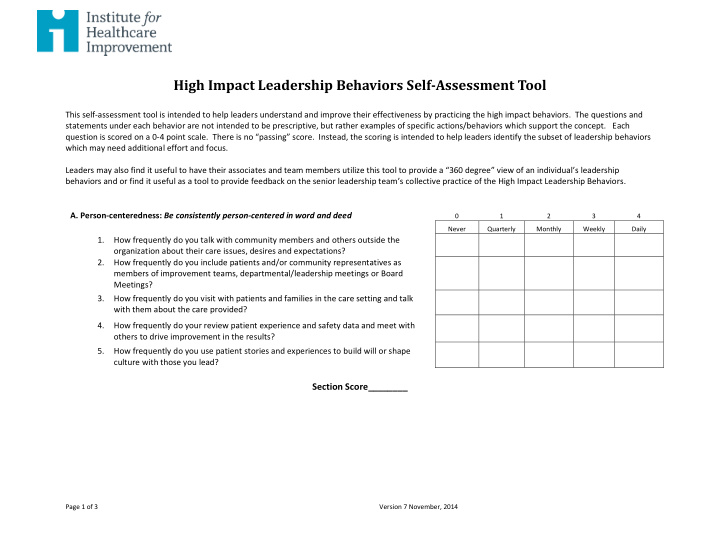



High Impact Leadership Behaviors Self-Assessment Tool This self-assessment tool is intended to help leaders understand and improve their effectiveness by practicing the high impact behaviors. The questions and statements under each behavior are not intended to be prescriptive, but rather examples of specific actions/behaviors which support the concept. Each question is scored on a 0-4 point scale. There is no “passing” score. Instead, the scoring is intended to help leaders identify the subset of leadership behaviors which may need additional effort and focus. Leaders may also find it useful to have their associates and team members utilize this tool to provide a “360 degree” view of an individual’s leadership behaviors and or find it useful as a tool to provide feedback on the senior leadership team’s collective practice of the High Impact Leadership Behaviors. A. Person-centeredness: Be consistently person-centered in word and deed 0 1 2 3 4 Never Quarterly Monthly Weekly Daily 1. How frequently do you talk with community members and others outside the organization about their care issues, desires and expectations? 2. How frequently do you include patients and/or community representatives as members of improvement teams, departmental/leadership meetings or Board Meetings? 3. How frequently do you visit with patients and families in the care setting and talk with them about the care provided? 4. How frequently do your review patient experience and safety data and meet with others to drive improvement in the results? 5. How frequently do you use patient stories and experiences to build will or shape culture with those you lead? Section Score________ Page 1 of 3 Version 7 November, 2014
B. Front-line Engagement: Be a regular authentic presence at the front line and a visible champion of improvement 0 1 2 3 4 Never Quarterly Monthly Weekly Daily 1. How frequently do you visit with front line staff about the problems that they face in delivering care? 2. How frequently do you review with front line team members their improvement projects efforts and results of their efforts? 3. How frequently do you teach and/or demonstrate improvement theory and methods to front line staff? 4. How frequently do you review and reprioritize a list of needed improvement priorities and projects? 5. How frequently do you participate with front line staff in formal improvement projects and/or lead an improvement team? Section Score________ C. Relentless Focus: Remain focused on the vision and strategy 0 1 2 3 4 Strongly Somewhat Somewhat Strongly Disagree Disagree Neutral Agree Agree 1. I can articulate and routinely discuss a clear vision of the future for my department/organization 2. I have a clear and executable strategy for achieving the vision and have created a focus on delivering results 3. The measurement system I use to monitor departmental/organizational performance and patient safety is aligned with the vision and linked to the strategies 4. I routinely talk about the vision and goals at every meeting and as a result, all team members understand the vision and how progress and success will be measured. 5. I have prioritized and aligned improvement and patient safety efforts with the vision and strategy and have provided adequate resources to accomplish the goals Section Score________ Page 2 of 3 Version 7 November, 2014
D. Transparency: Require transparency about results, progress, aims and defects 0 1 2 3 4 Strongly Somewhat Somewhat Strongly Disagree Disagree Neutral Agree Agree 1. I have ensured that key departmental/organizational clinical quality, safety, service performance measures are posted and available to all team members on a real time basis 2. When rounding, I talk with team members about their unit's posted performance and project measures 3. I ensure that departmental/organizational clinical, safety and service performance data is shared and available to patient and family members, and the community at large. 4. When a patient harm event occurs, I ensure that patient and family members are fully informed ASAP. 5. When a team member believes that a patient is about to be harmed, they speak up and/or intervene. Section Score________ E. Boundarylessness: Encourage and practice system thinking and collaboration across boundaries 0 1 2 3 4 Strongly Somewhat Somewhat Strongly Disagree Disagree Neutral Agree Agree 1. The care redesign efforts I lead/sponsor cross multiple departmental, organizational and professional boundaries. 2. I arrange or foster participation and collaboration with others beyond my direct management control and influence. 3. The clinical information needed to care for an individual patient flows easily across organizational, other provider and community boundaries. 4. When a patient in my department/organization requires care beyond what we provide, the transfer/handoff to other clinicians, providers, or services is always handled smoothly and efficiently. 5. I am generous with power, sharing leadership of population health improvement with others in the community and/or across organizational boundaries. Section Score___________ Overall Score_____________ Page 3 of 3 Version 7 November, 2014
Recommend
More recommend